Neo Geo CD
Top 10 Best Neo Geo CD Games of All Time!
The Neo Geo MVS (Multi Video System) was a powerful arcade platform from SNK that launched in 1990. A home version – dubbed the AES (Advanced Entertainment System) – hit the market the following year with the same specs as the arcade hardware. Playing arcade-perfect ports wasn’t cheap, however. The AES had a $650 price tag attached to it, and you could expect to drop another $200-$300 dollars per game! In 1994, with the next generation of consoles looming on the horizon, SNK released a CD-based version of the console. The Neo Geo CD was a more affordable option than the AES, and the disc-based games could be found for a fraction of the price. Sadly, the system used a single-speed disc drive and the console was plagued by lengthy loading times. An updated version of the console, known as the Neo Geo CDZ, effectively cut the loading times in half, but this revision was never released outside of Japan. The Neo Geo CD’s library was mostly comprised of AES ports, but there are several reasons why it warrants its own list. Half of the games on our AES list were never released on disc, after all, and the loading times made certain games a chore on CD. These problems were especially noticeable in fighting games, and it wasn’t unusual for the load screens to last longer than the matches themselves! I was concerned that a Neo Geo CD list would be a facsimile of our previous AES list, but it has a completely different flavor.
10
Magician Lord
1994
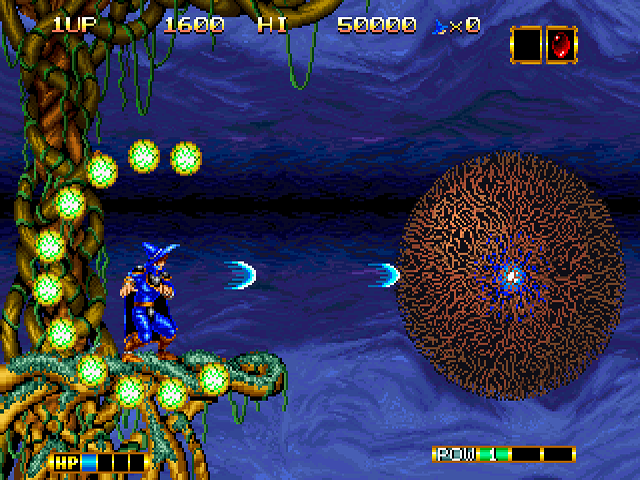
Magician Lord is an action-platformer that served as a launch title for both the arcade-based Neo Geo MVS and the home-based Neo Geo AES systems. Assuming the role of the titular magician, players work their way through various castles, caves, and forests. The environments are rich with Gothic themes, and players will encounter a myriad of fantasy-based monsters during their adventure. The play mechanics aren’t especially innovative, but there are a few things that help set it apart from other games in the genre. Without question, the “transformation” gimmick is its most notable feature. By collecting color-coded orbs in the levels, the magician can change into one of six different forms. These transformations include a fire-breathing dragon, an agile shinobi, and a powerful samurai, among others. Each form has its own unique traits, and everything from attack power to jumping abilities will be altered. Although Magician Lord was an effective launch game for SNK’s newly-minted console in 1991, it had lost some of its shine by the time the Neo Geo CD version hit store shelves. The graphics simply aren’t as sophisticated as late-era Neo Geo games, but this likely works to its favor since it eliminates the need for excessive loading screens. It’s just unfortunate that the developers didn’t include any extras for the CD release. I would have loved to hear an arranged soundtrack.
9
Magical Drop 2
1996
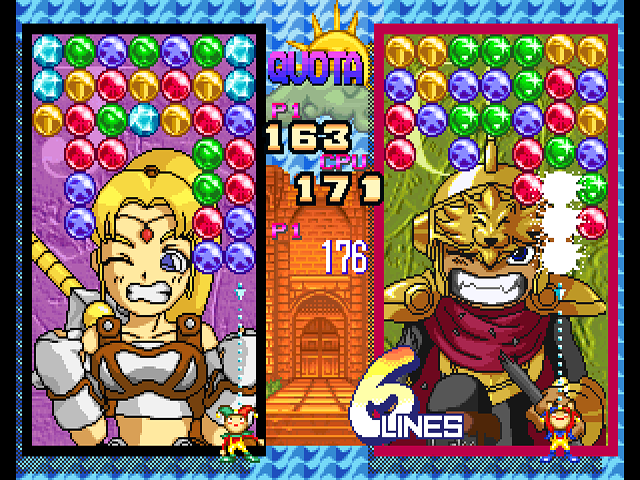
The Magical Drop games are standard fare as far as puzzle games go. The object is to stack colored balloons that descend from the top of the screen in an effort to group similar colors together. By lining up three balloons of the same color, players can clear them off the board and potentially set up chain reactions. One aspect that separates Magical Drop from its contemporaries is its character-based gameplay. The game features ten characters, and each has their own attack patterns. These patterns affect how fast their opponent’s column will descend, and certain characters can even cause individual columns to move at uneven rates to make it more difficult to line up similar colors. Magical Drop 2 introduced a handful of new characters and included a reimagined single player mode, but the core game felt like a refined version of its predecessor in many regards. Although the Neo Geo CD port was nearly identical to the cartridge version, the enhanced audio was a welcome addition. If you’re looking for a puzzle game that demands quick reflexes, then Magical Drop 2 is the game for you!
8
Baseball Stars 2
1994
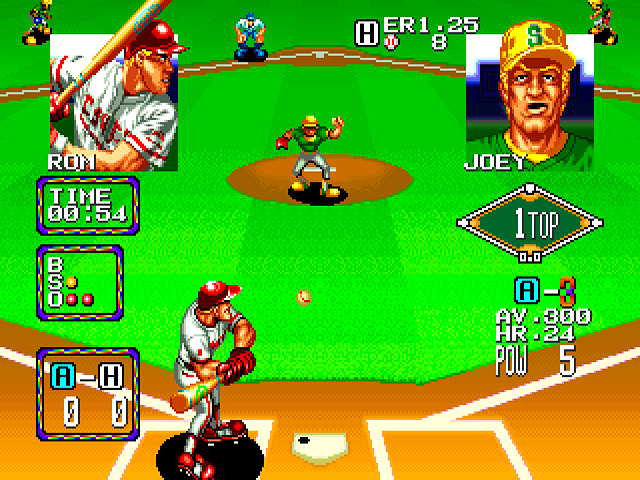
I’m not a big fan of sports games, but Baseball Stars 2 was clearly developed with an arcade mentality in mind. The pacing is decidedly faster than the real sport, and there are only a handful of teams to choose from. Players can call time outs and use pinch hitters, but the game moves along at breakneck speeds and you’re not expected to micro-manage anything. It’s a lot flashier than most baseball games too! The game provides animated close-ups of both the pitcher and the batter, and brief cut scenes are played during dramatic catches or close plays. When a player hits a home run, the entire team is there to congratulate them at home plate. (Even the mascot joins the celebration!) The characters also show signs of anger when things don’t go their way, and they will even break bats in frustration. The original Baseball Stars (released on the NES in 1989) was more akin to a simulation, while the sequel is all about accessibility. Whether you’re in a 15-game tournament against the computer or playing a few innings against a friend, the game is a blast. There are plenty of sports games with more depth, but few of them are as fun as Baseball Stars 2.
7
Pulstar
1995
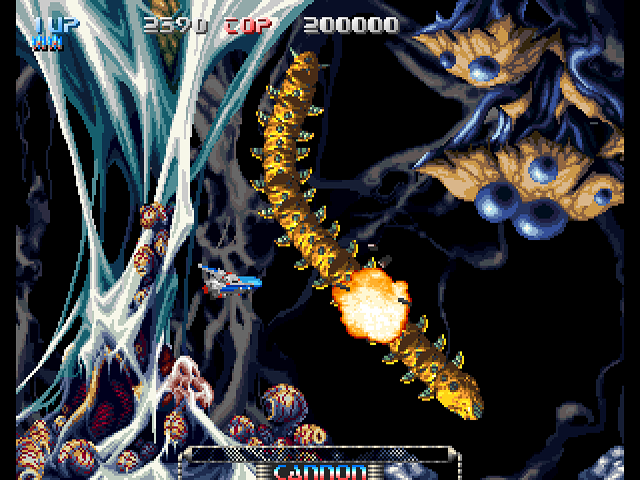
Pulstar is a side-scrolling shoot ’em up that could be likened to R-Type in many regards. The influence is apparent from the moment you start playing. The setting, graphical style, and play mechanics in Pulstar are exactly what you’d expect from a proper R-Type sequel. Some shooters simply require players to blast everything in sight, but Pulstar requires a little more thought. A lot of the strategy is deciding when to shoot and when to charge your weapon, since you will left them open for attack during the charging phase. Pulstar features a variety of power-ups to collect, but its innovative double-sided weapon meter defines the action. This meter moves to the right side when the player holds the fire button down and to the left when the player hits the fire button rapidly. If the meter is fully charged on the right side, the player’s ship will release a powerful energy blast. If the meter is fully charged on the other side, however, players will unleash a barrage of smaller, rapid blasts. Effectively utilizing power-ups and charged shots is essential if players wish to progress in the game. Pulstar has an “old school” mentality, which is basically a nice way of saying that it was designed to kick your ass. It’s exceedingly difficult, but fans of classic arcade shoot ’em ups wouldn’t want it any other way.
6
Top Hunter: Roddy & Cathy
1994
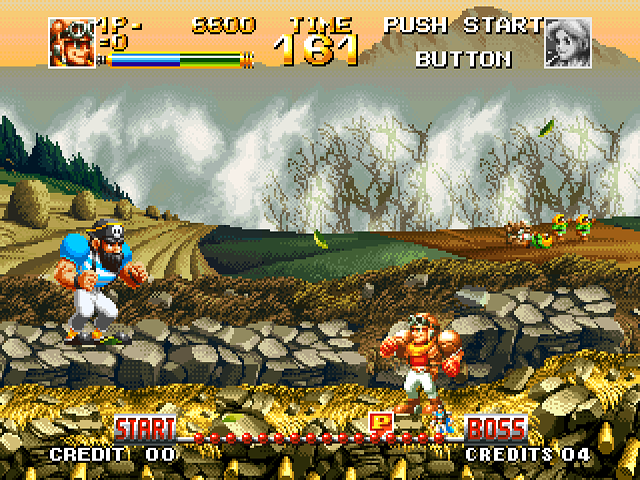
A side-scrolling beat ’em up with a strong platforming component, Top Hunter: Roddy & Cathy could be likened to Joe & Mac or Spinmaster. Roddy and Cathy are galactic bounty hunters who attack their foes with extendable arms and killer yo-yos respectively. They can also jump on their enemies or execute special attacks with Street Fighter-inspired joystick gestures. They’ll be able collect various firearms along the way, too, and they can even pilot single-occupant bi-pedal mechs! If no weapons are available, our heroes can simply hurl objects across the screen. (Throwing snowmen at your enemies isn’t normal, but on meth in Top Hunter it is!) One of the coolest things about the game is how players can hop back and forth between the background and foreground layers. This allows you to avoid obstacles or collect items, and it prevents the game from feeling too claustrophobic if a second player joins in. Top Hunter isn’t especially lengthy or challenging, but each stage has a unique theme and the level layouts change in accordance to the order they’re chosen. Nevertheless, many critics took issue with its brevity upon its release in 1994. The AES cartridge came with a $300 price tag that likely scared most consumers away, so the Neo Geo CD version was a steal at $50. Top Hunter wasn’t a genre-defining game like Metal Slug, but it’s a great option for anyone looking for a fun co-op experience. I haven’t even mentioned the skateboarding bonus stages!
5
Shinsetsu Samurai Spirits: Bushidō Retsuden
1997
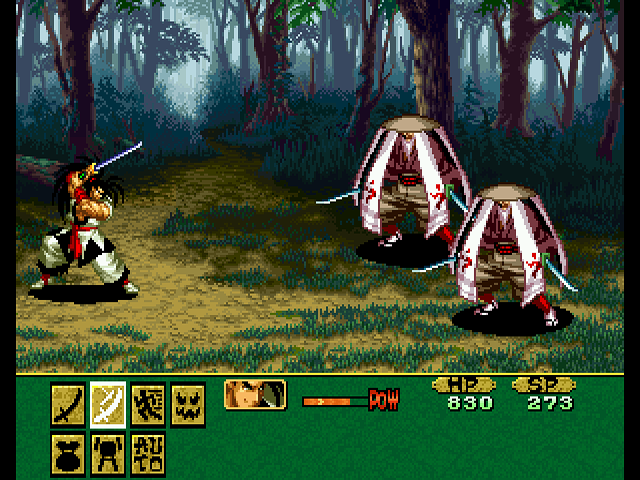
There were only eight Neo Geo CD games that weren’t also released on either the home-based AES or the arcade-based MVS. Shinsetsu Samurai Spirits: Bushidō Retsuden is the most notable “exclusive” and the closest thing to a killer app on SNK’s disc-based console. For the uninitiated, Samurai Spirts is a weapons-based fighting game franchise that’s known as Samurai Shodown outside of Japan. The games were well-suited to an RPG spinoff since they were loaded with compelling characters and set against the backdrop of an interesting historical period. Bushidō Retsuden is basically a retelling of the first Samurai Spirts and its sequel. It explains things in much greater detail, of course, and we learn a lot more about the characters. Players choose the main protagonist from a roster of six characters, but everyone from the first two Samurai Spirits games is included in one way or another. The game itself is standard fare as far as RPGs go, and you’ll spend a lot of time exploring dungeons, upgrading weapons, and chatting up NPCs. The battle sequences look like they were transplanted from Final Fantasy, but players are able to execute special moves with specific joystick gestures. This makes the game feel more like the original fighting games, and it’s much more engaging that simply selecting your attack from a list. Unfortunately, Bushidō Retsuden can be an exercise in frustration since you have to suffer through egregious loading screens before every battle. The difficulty spikes also caught me off guard, and the standard attack is basically useless. I loved the setting and the characters, however, and the game looks better than the subsequent PlayStation and Saturn ports. Unfortunately, the game has ever been released outside of Japan and no fan translations have been completed. If you want to play the game and don’t speak Japanese, you better have a good translation app and a lot of patience!
4
Puzzle Bobble
1995
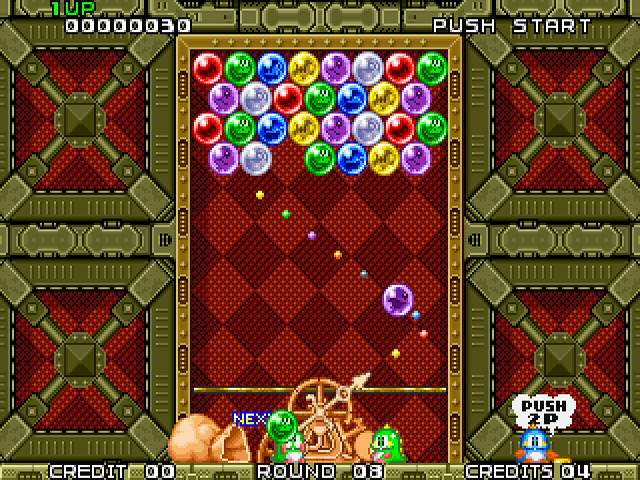
Puzzle Bobble is a competitive puzzle game from Taito that features characters from the Bubble Bobble universe. The play mechanics could not be easier to understand, and that’s one of the reasons why it was so successful. Players are tasked with shooting colored bubbles into the playing field in an effort to group similar colors together. When three or more bubbles of the same color are connected, they will pop and disappear from the screen. The puzzle elements are relatively subdued, and the game is more focused on aiming than it is on any real puzzle-solving skills. Even the more advanced techniques (like ricocheting bubbles off of walls) are easy to grasp. The simple premise made Puzzle Bobble a hit in the arcades, but Taito never bothered to port the game to the Neo Geo AES. AES games typically retailed for $200 or more, so I can understand why Taito would have reservations about porting the game to SNK’s luxury console. The Neo Geo CD offered a completely different value proposition, however, and it was a more appropriate platform for Puzzle Bobble‘s casual audience. It’s not the most technically advanced game on this list, but it’s fun, competitive, and highly replayable.
3
Neo Turf Masters
1996
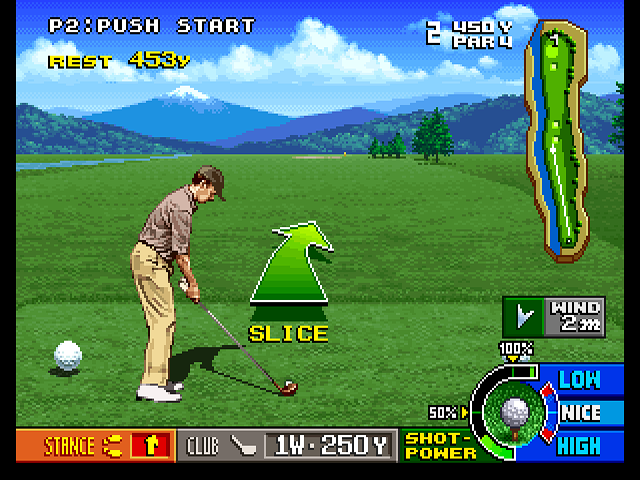
Golf is relatively slow moving as far as spectator sports go. As such, it isn’t the most likely candidate for an arcade-style game. Thankfully, Neo Turf Masters isn’t nearly as boring as real golf is. The game isn’t as outlandish as Hot Shots Golf or Mario Golf, but it still moves along faster than the real sport does. Even though the physics and rules are in line with typical sports sims of the era, you don’t need to be interested in golf in order to enjoy Neo Turf Masters. The intuitive control scheme keeps things simple, and those playing the game for the first time will have no problem figuring out how to adjust the power and trajectories of their shots. This isn’t to say that the game has no depth, however. With five 18-hole courses from around the globe, it will take players a while before they see everything there is to see. The CD version was packed with extra features, new game modes, and an arranged soundtrack. It also had a hidden course that wasn’t available elsewhere! Despite the loading times, the Neo Geo CD version of Neo Turf Masters is arguably superior to its cartridge-based counterpart.
2
Windjammers
1995
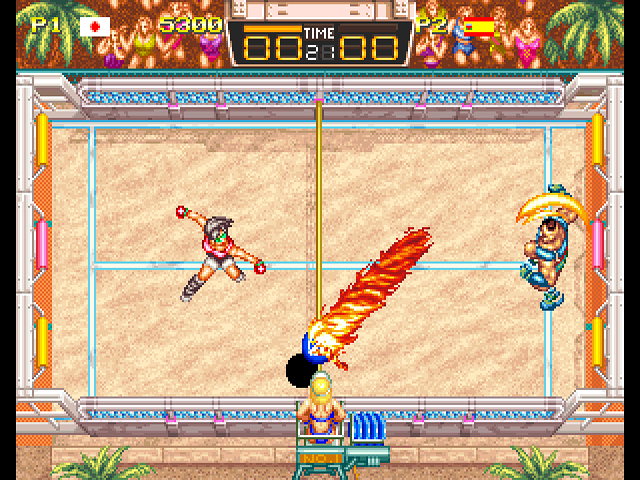
Windjammers – known as Flying Power Disc in Japan – is basically a modified version of air hockey. The object of the game is for opposing players to throw a frisbee into their opponent’s goal. This premise is (almost) as old as video games themselves, and the core mechanics could be likened to Pong in many regards. The flying discs ricochet off walls at incredible speeds, and players have some level of control over how their throws will curve. You’ll need quick reflexes if you want to intercept the discs, and the slide maneuver helps in this regard. The roster is comprised of six characters, and each has their own stats and special abilities. Naturally, their signature moves completely disregard the laws of physics. (As an example, one of the athletes will set the disc ablaze and cause it to snake up and down the court!) Windjammers was met with middling reviews upon its initial release, but the benefit of hindsight has allowed the game to enjoy a resurgence in popularity. The game was previously included on our list of best Neo Geo AES games, and the Neo Geo CD version is even better in some ways. In the AES version, a set would end when a player reached 12 points or after 30 seconds had elapsed. On the Neo Geo CD, these values were changed to 25 points and 90 seconds respectively. This made things more competitive and gave the players enough time to mount a comeback if they fell behind. This small adjustment is enough for me to recommend the Windjammers on the Neo Geo CD over the cartridge version.
1
Metal Slug
1996
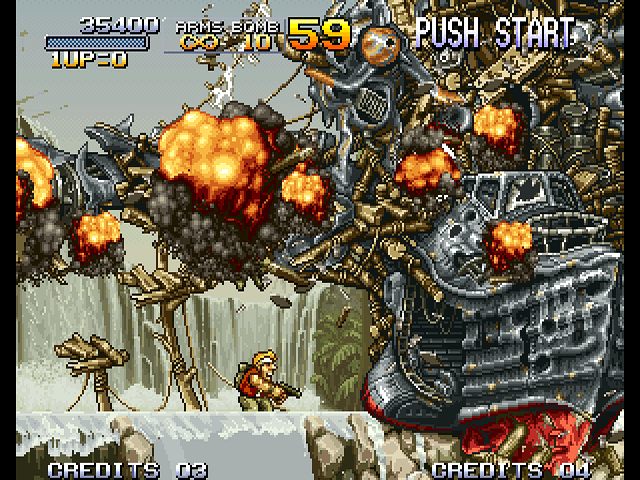
Metal Slug is one of the first games that comes to mind when discussing the Neo Geo. The ambitious run-and-gun series is largely defined by intense action and amazing graphics. The hand-drawn visuals are still impressive decades after its initial release, and they seem even more special in today’s environment since most developers have abandoned pixel art altogether. Metal Slug is cut from the same cloth as Contra in many regards, but the action is more over-the-top. The game throws a tremendous amount of enemies at the player, and the screen-filling bosses are especially impressive. The stages are breathtaking too, and I was taken aback by how much of the scenery could be destroyed. On the topic of destruction, players are given many ways to dispatch their enemies. There is an impressive assortment of weapons – including pistols, shotguns, grenades, rocket launchers, and flamethrowers – and players also have a knife for close-range melee attacks. The star of the show is the eponymous “Metal Slugs”, which are single-occupancy tanks that can literally run through enemy soldiers. The action never feels mindless, however, as players are tasked with rescuing prisoners in each stage. There were only two Metal Slug games released for the Neo Geo CD, but the first one is definitely the one to get. The sequel is marred by significant slowdown, and the loading times are unbearable. The first entry is missing some animation frames and sound samples, but it fares much better on the CD format than the sequel. The new “Combat School” was a nice touch as well, and I liked being able to re-visit earlier missions with new objectives. The first Metal Slug is the most balanced game in the series with respect to its difficulty, and I’m happy to (finally) give it a brighter spotlight on this website.

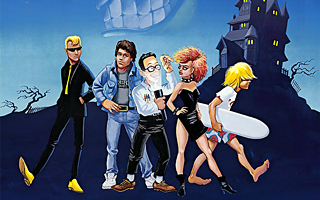
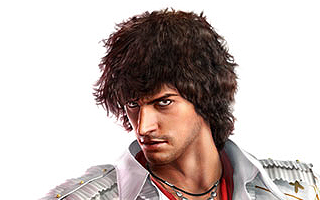
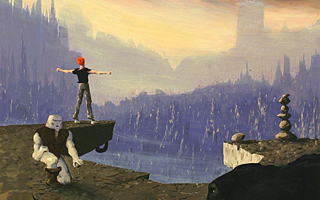
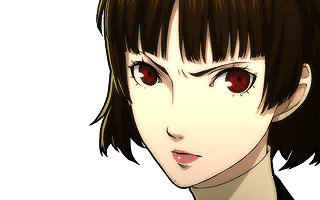
Do you agree with this list? Let us know what you think by leaving a comment below. Your opinion matters!